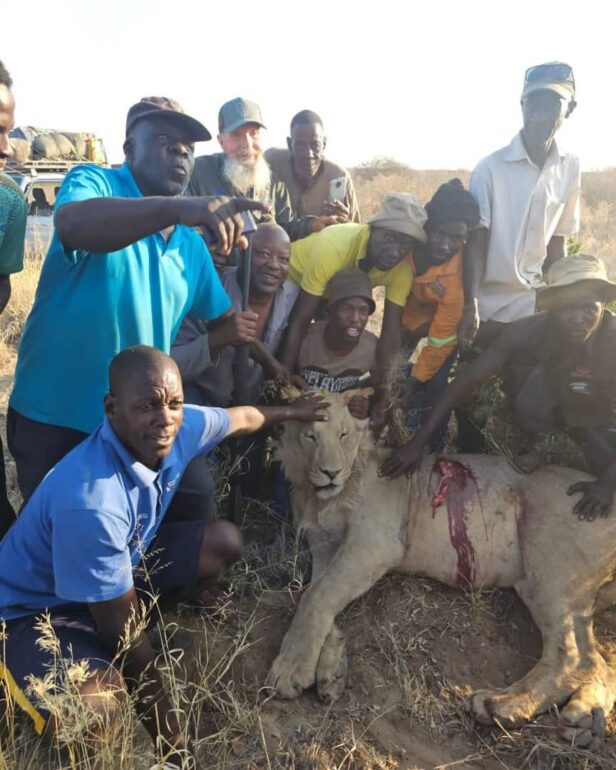Omanyano ovanhu koikundaneki yomalungula kashili paveta, Commisiner Sakaria takunghilile
Veronika Haulenga
Omanyano ovanhu koikundaneki yomalungula kashili paveta, Commisiner Sakaria takunghilile
Veronika Haulenga
Listeners:
Top listeners:
-
play_arrow
Omanyano ovanhu koikundaneki yomalungula kashili paveta, Commisiner Sakaria takunghilile Veronika Haulenga
Namibia’s Media Ombudsman Condemns the publishing of photo depicting dead lion


By Vitalio Angula
The publication of a photo depicting a lion that was tracked down and killed by rangers from Namibia’s Ministry of Environment, Forestry and Tourism on Saturday, 10 August (World Lion Day), has sparked controversy. Media Ombudsman John Nakuta has described the publication on the New Era Newspaper’s Instagram account as unethical and inconsistent with the high standards of reporting expected from Namibian media.
“In the context of the lion that has been killed, one can regrettably say that the photographing and the publication of the dead lion, along with the depiction of the people involved, are unfortunately inconsistent with the noble standards of ethical reporting, lawful reporting, and the non-glamorization of violence,” Nakuta said. He emphasized that this goes against the requisite standards of conduct as set by the Code of Conduct for Namibian Media.
The lion, which was among two others that entered Namibia from Botswana, had been blamed for killing and threatening livestock in the Eastern Omaheke region. It was designated as a problem animal, leading to its tracking and subsequent killing.
Deputy Director at Namibia’s Ministry of Environment, Colgar Sikopo, noted that while the Nature Ordinance of Namibia, the law protecting the country’s wildlife, is silent on the publication of photos depicting harm to animals, the revised policy on human-wildlife conflict—which is being translated into law—addresses this issue. “The Wildlife and Protected Areas Management Bill is at an advanced stage, and we hope it can be enacted before the end of this year,” Sikopo said. He added that this will help control and enforce the prohibition of publishing photos of animals being “destroyed” due to the negative impact such images may have on Namibia’s reputation in nature conservation.
Tammy Hoth, speaking on behalf of the Namibia Lion Trust, criticized the photo of the killed lion for potentially sending the wrong message and undermining the country’s conservation efforts. She described the photo as inhumane and lacking sensitivity towards those who are concerned about lions and other mammals threatened by poaching and natural phenomena like droughts.
“The negative impact on social media is significant. Unfortunately, the people behind the camera are relieved that the lion that killed their livestock is now dead. They do not understand what lion conservation entails; they just want them gone,” Hoth remarked. She suggested that the photo should have been blurred to make it more acceptable for mainstream media.
Addressing the rising cases of human-wildlife conflict in Namibia, driven by drought, habitat loss, and human encroachment, Hoth noted that while translocations and relocations are possible, they are complex, especially for lions. “Unless these animals are known to researchers and fitted with GPS collars for monitoring, very little can be done to remove them humanely and relocate them far from farmland,” Hoth explained.
Ministry of Environment authorities reported that three lions that moved into Namibia from Botswana have been responsible for killing and attacking several livestock in the Omaheke region. Spokesperson of the Ministry Romeo Muyunda said that the ministry is preparing a report for the media, which will quantify the livestock losses and clarify the ministry’s stance on publishing photos of lions that have been “destroyed” by authorities.
Editor of the government-owned New Era newspaper, Jonathan Beukes, defended the publication, stating that it was deemed newsworthy and in the public interest. “Whenever it is newsworthy, we will publish. The specific area and the circumstances of the lion’s demise justify the publishing of the photo,” Beukes said. When asked about concerns from animal welfare groups, Beukes responded, “Animal welfare groups are usually white imperial-minded groups, and we don’t need to dance to their tune.”
Written by: Staff Writer
Animal Welfare Colgar Sikopo ethical reporting Human wildlife conflict John Nakuta Jonathan Beukes lion photo Namibia Namibia Lion Trust Namibian media Namibian Ministry of Environment New Era Newspaper Tammy Hoth Wildlife and Protected Areas Management Bill World Lion Day
Similar posts
China donates 1375 metric tons of rice toward drought relief
https://youtu.be/OisosYtX9v0 By: Ellen Shihepo The People's Republic of China has donated 1375 metric tons of rice worth over N$50 million to the government's drought relief programme. Chinese Ambassador Zhao Weiping said the donation was initially decided on during a bilateral meeting between Chinese President Xi Ping and President […]
Windhoek Weather
Most popular

Mbumba signs off new benefits for retired political office bearers

Namdia Heist: More questions, lots of confusion

Omuhwahwameki Michael okuunganeka oshikonga shoku patitha oostola dho Rani moshilongo ashihe.

Walvis Bay woman loses over N$777.000 to a fraudster

Don’t let Pohamba’s tears over Nujoma’s death go to waste
Copyright 2025 Future Media (Pty) Ltd | Website by Digital Platforms
Tel: +264 83 000 1000 | Email: news@futuremedia.com.na




